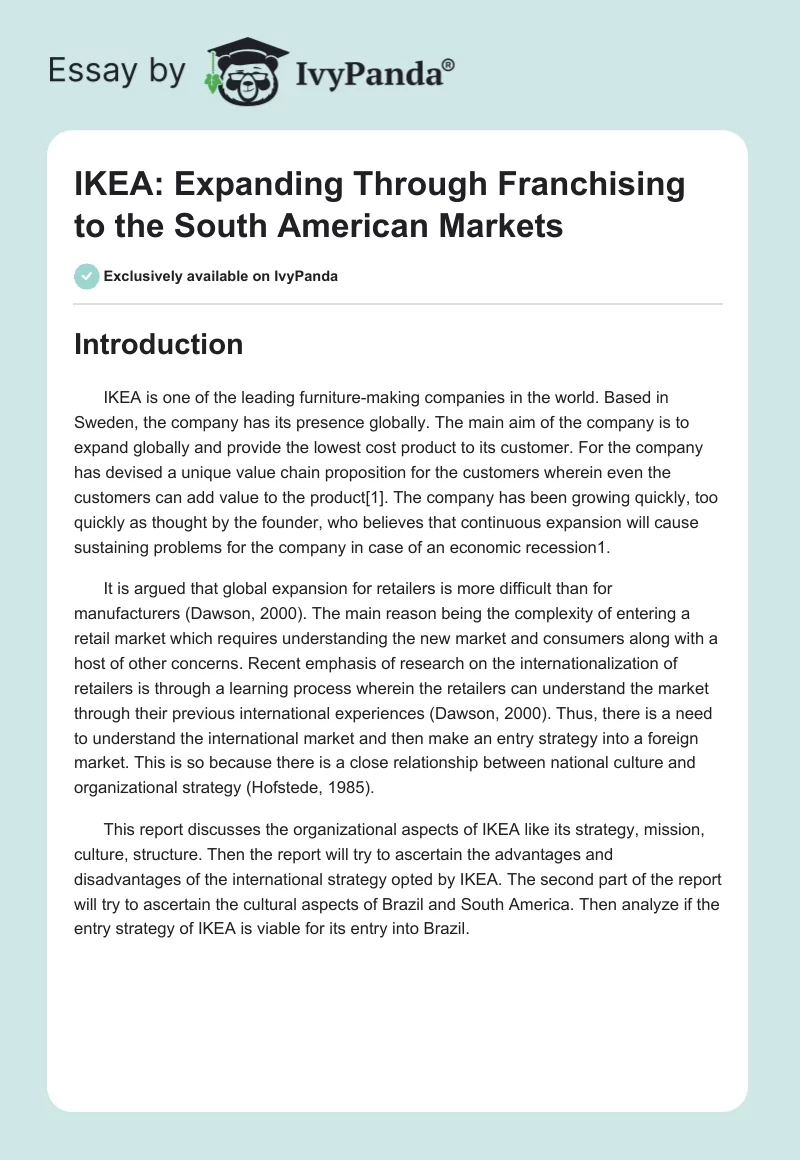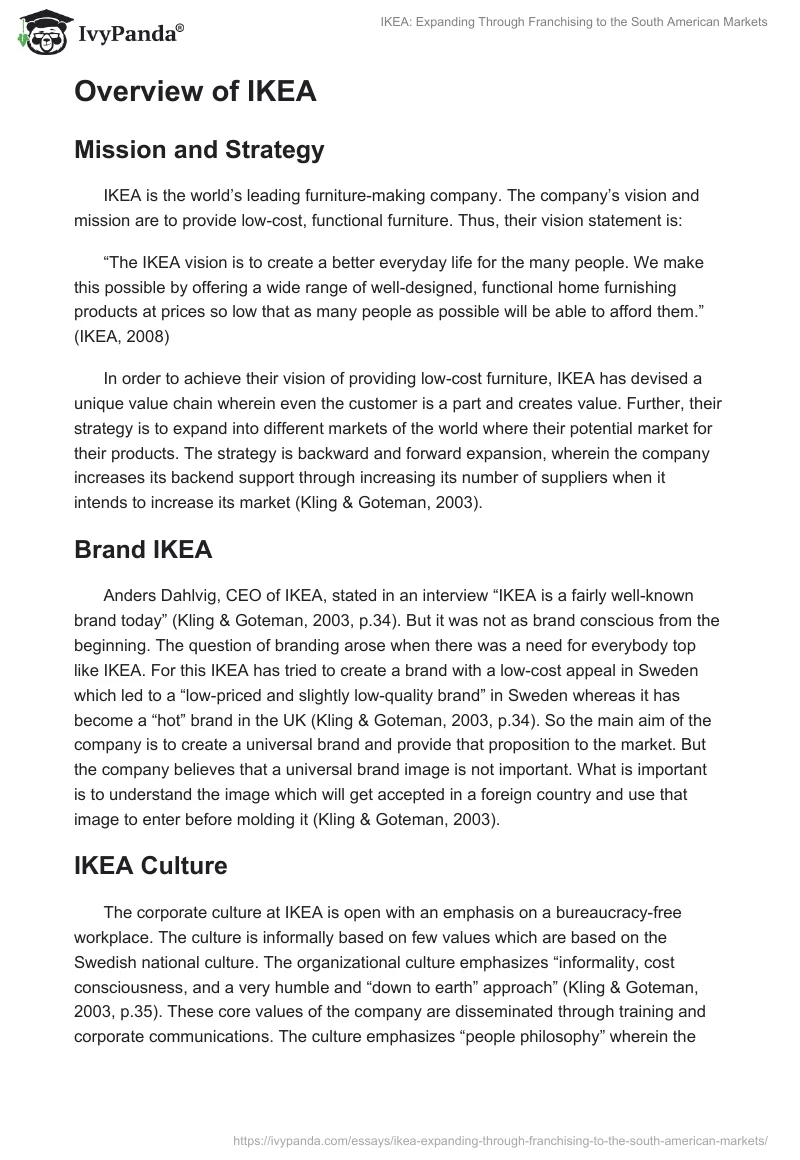Introduction
IKEA is one of the leading furniture-making companies in the world. Based in Sweden, the company has its presence globally. The main aim of the company is to expand globally and provide the lowest cost product to its customer. For the company has devised a unique value chain proposition for the customers wherein even the customers can add value to the product[1]. The company has been growing quickly, too quickly as thought by the founder, who believes that continuous expansion will cause sustaining problems for the company in case of an economic recession1.
It is argued that global expansion for retailers is more difficult than for manufacturers (Dawson, 2000). The main reason being the complexity of entering a retail market which requires understanding the new market and consumers along with a host of other concerns. Recent emphasis of research on the internationalization of retailers is through a learning process wherein the retailers can understand the market through their previous international experiences (Dawson, 2000). Thus, there is a need to understand the international market and then make an entry strategy into a foreign market. This is so because there is a close relationship between national culture and organizational strategy (Hofstede, 1985).
This report discusses the organizational aspects of IKEA like its strategy, mission, culture, structure. Then the report will try to ascertain the advantages and disadvantages of the international strategy opted by IKEA. The second part of the report will try to ascertain the cultural aspects of Brazil and South America. Then analyze if the entry strategy of IKEA is viable for its entry into Brazil.
Overview of IKEA
Mission and Strategy
IKEA is the world’s leading furniture-making company. The company’s vision and mission are to provide low-cost, functional furniture. Thus, their vision statement is:
“The IKEA vision is to create a better everyday life for the many people. We make this possible by offering a wide range of well-designed, functional home furnishing products at prices so low that as many people as possible will be able to afford them.” (IKEA, 2008)
In order to achieve their vision of providing low-cost furniture, IKEA has devised a unique value chain wherein even the customer is a part and creates value. Further, their strategy is to expand into different markets of the world where their potential market for their products. The strategy is backward and forward expansion, wherein the company increases its backend support through increasing its number of suppliers when it intends to increase its market (Kling & Goteman, 2003).
Brand IKEA
Anders Dahlvig, CEO of IKEA, stated in an interview “IKEA is a fairly well-known brand today” (Kling & Goteman, 2003, p.34). But it was not as brand conscious from the beginning. The question of branding arose when there was a need for everybody top like IKEA. For this IKEA has tried to create a brand with a low-cost appeal in Sweden which led to a “low-priced and slightly low-quality brand” in Sweden whereas it has become a “hot” brand in the UK (Kling & Goteman, 2003, p.34). So the main aim of the company is to create a universal brand and provide that proposition to the market. But the company believes that a universal brand image is not important. What is important is to understand the image which will get accepted in a foreign country and use that image to enter before molding it (Kling & Goteman, 2003).
IKEA Culture
The corporate culture at IKEA is open with an emphasis on a bureaucracy-free workplace. The culture is informally based on few values which are based on the Swedish national culture. The organizational culture emphasizes “informality, cost consciousness, and a very humble and “down to earth” approach” (Kling & Goteman, 2003, p.35). These core values of the company are disseminated through training and corporate communications. The culture emphasizes “people philosophy” wherein the company emphasizes its global workforce. This emphasis on a workforce portrays the open culture of IKEA.
Expansion Strategy
The company’s expansion strategy is conservative. The company does not open a retail store in a potential market but distributes/supplies its products through a franchisee. The strategy is a “risk-reducing” approach. The company follows a subsidiary expansion in the United States and the UK, but in all other countries, it has franchisees.
The expansion strategy of IKEA is essentially a centralized expansion strategy where the corporate control remains with the headquarters and the distribution and retailing powers are only provided to the operations in foreign countries. This high degree of centralization of the company leads to increased problems with complex logistics, lack of cultural sensitivity, and demographic differences in different countries. The organizational structure was centralized at IKEA. This helped to maintain greater control over the international operations but with greater expansion plans, the company needed to alter its structure as well as decentralize its control (Jonsson & Elg, 2006). The expansion strategy that IKEA follows is “based on a standardized concept that is adapted to a limited extent to different cultural settings” (Jonsson & Elg, 2006, p.246). This shows that IKEA’s strategy for entry into foreign markets is tailor-made depending on the cultural needs of the national culture.
Changes Required
The company presently faces a lot of difficulty in trying to merge with the international markets due to cultural and demographic differences. Research shows that while expanding it is wise for a retailer to enter physically distant and different markets as there is more potential for growth there (Evans et al, 2008 ). But research also indicates that there should be a positive relationship between the physical distance of expansion and the degree of decentralization (Evans et al, 2008 ). Evens et al. state: “This study suggests that in entering psychically distant markets, retailers adopt low-cost/low-control entry strategies and adapt their retail strategy to a greater extent than in psychically close markets.” (Evans et al, 2008, p.55)
Hofstede (1981; 1985; 2007) believes that no two cultures are similar, so it is very important to understand the underlying sentiments, value system, and beliefs of the country before making the entry strategy. So it is important to understand the culture of the country before planning to enter. Culture may be defined as
“…the collective programming of the human mind that distinguishes the members of one human group from those of another. Culture, in this sense, is a system of collectively held values.” (Hofstede, 1981, p.24) Thus, with different value systems, the whole culture can become mismatched as “national background affects and constrains our ability to recognize important cultural differences” (Hofstede, 2007, p.20). So it is important to understand the culture of the country where the company enters.
Brazil Market Analysis
Brazil’s market is highly attractive and a lucrative market for IKEA. The country has a growth rate of 3.8 percent (DATAMONITOR, 2008). The Pestle analysis shows that Brazil has a lucrative market but there are political and economic risks associated with the country which might cause problems in the expansion plan (DATAMONITOR, 2008). According to the case study, the growth potential for the country especially in the case of furniture is immense. A few problems as identified by the report are corruption, unemployment, bureaucracy, and high inflation (DATAMONITOR, 2008). But the demographic characteristics of the country are promising for IKEA which targets young households. 68.4 percent of the population is between the age group of 15 years to 64 years (DATAMONITOR, 2008), which increases the market base for the product.
But there remains a cultural difference in the European and Brazilian cultures. Using Hofstede’s dimensions of culture, we try to ascertain the culture of Europe and Brazil. The cultural dimensions of Hofstede are masculinity, power distance, long-term orientation, and individualism. We see that Brazil is average on masculinity, and power distance. Here the long-term orientation is low and low on individualism. Whereas in Europe individualism is high and masculinity is average. Power distance is high and high on long terms orientation. This shows that there exists a huge difference in the culture of Brazil and that of Europe. Further, like IKEA’s culture is highly influenced by the national culture of Sweden (Kling & Goteman, 2003), and as is expected by most organizational cultures (Hofstede, 1985), it is important to make the culture of IKEA align to that of Brazil before entering the market. Further attention must be given to building a strong strategy for the organization which will promote a brand that holds the same meaning to all. So the creation of a universal brand must be of priority before entering Brazil or any other foreign markets.
References
DATAMONITOR, 2008. Brazil: Country Analysis Report. Country Analysis Report. DATAMONITOR
Dawson, J., 2000. Retailing at century end: some challenges for management and research., International Review of Retail, Distribution and Consumer Research 10(2), p. 119–148.
Evans, J., Mavondo, F.T. & Bridson, K., 2008. Psychic Distance: Antecedents, Retail Strategy Implications, and Performance Outcomes., Journal of International Marketing 16(2), p. 32–63.
Hofstede, G., 1981. CULTURE AND ORGANIZATIONS., International Studies of Management and Organizaitons X(4), p. 15-41.
Hofstede, G., 2007. A European in Asia., Asian Journal of Social Psychology 10, p. 16–21.
Hofstede, G., 1985. The Interaction Between National and Organizational Value Systems., Journal of Management Studies 22(4), p. 347-59.
IKEA, 2008. Inter IKEA Systems B.V. [Online]. Available at: HYPERLINK “Web.
Jonsson, A. & Elg, U., 2006. Knowledge and Knowledge Sharing in Retail Internationalization: IKEA’s Entry into Russia., Int. Rev. of Retail, Distribution and Consumer Research 16(2), p. 239 – 256.
Kling, K. & Goteman, I., 2003. IKEA CEP Anders Dahlvig on international growth and IKEA’s unique corporate culture and brand identity., Academy of Mnagement Executive 17(1), p. 31-9.


